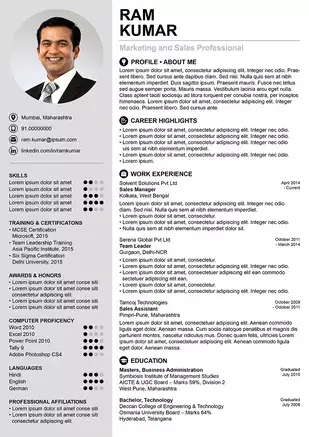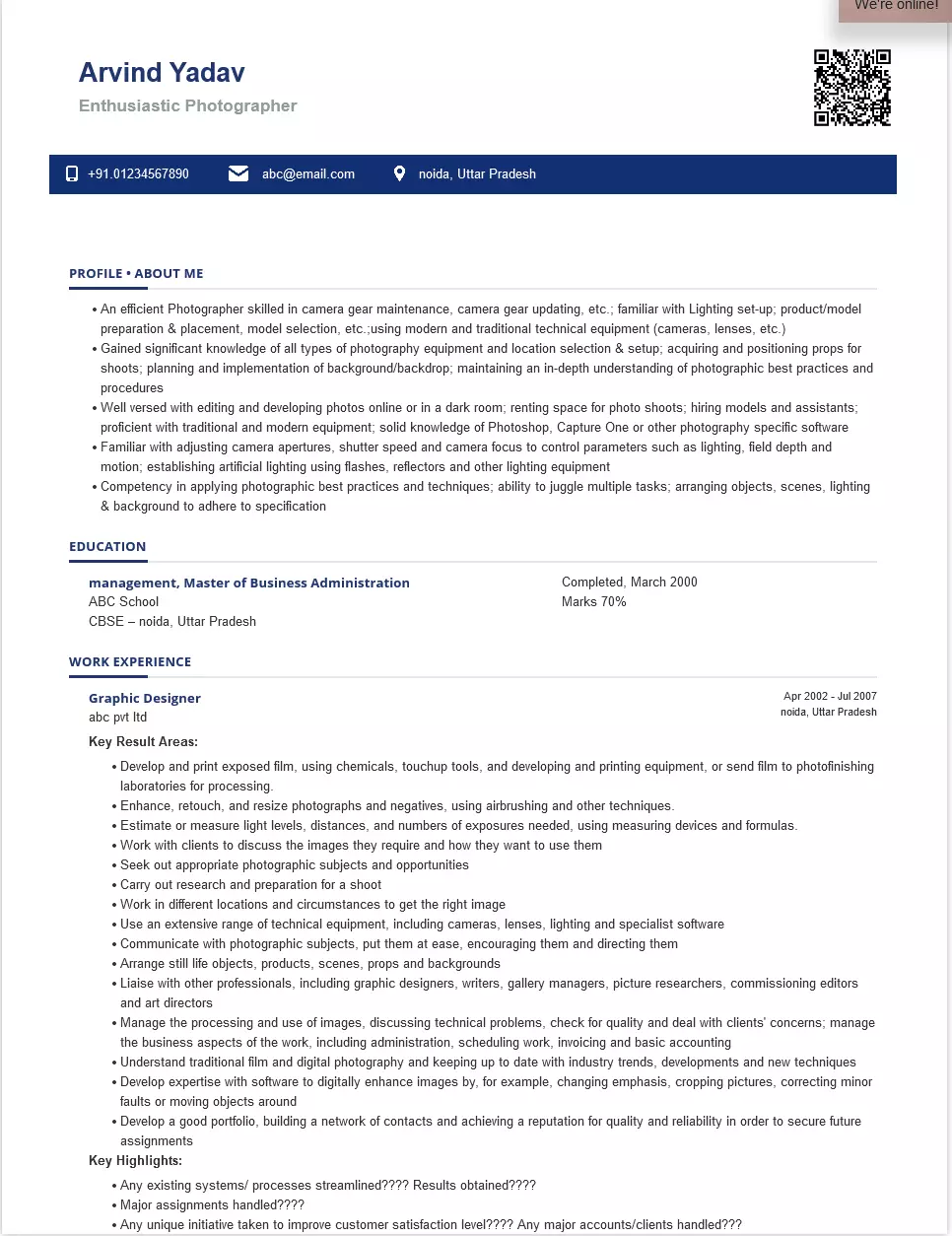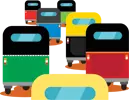Gave Morning classes to slum children
What's your job?
Graphic Designer Resume Samples and Templates for 2026
- Table of Contents
- Downloadable Sample
- Resume Tips from Experts
- Resume Text Version
- Share
Graphic Designer Resume Guide for India
A well-crafted graphic designer resume is essential for success in India’s thriving creative and digital economy. Whether you’re a fresher starting your career after completing a design degree from NID or NIFT, or an experienced professional seeking growth at top agencies like Ogilvy India, Dentsu, or leading tech companies like Flipkart and Swiggy, this guide provides everything you need to create a standout resume that impresses Indian employers and passes ATS screening on portals like Naukri and LinkedIn.
This comprehensive guide includes:
- Resume format recommendations for India
- Key skills Indian employers look for
- Complete resume example with Indian context
- Top graphic designer employers in India
- Salary insights in INR by experience level
- Portfolio and certification guidance
- ATS optimization tips for Indian job portals
Why Your Graphic Designer Resume Matters in India
India’s creative and design industry employs over 5 lakh professionals, with companies like Ogilvy India, Dentsu, Wunderman Thompson, Flipkart, and Zomato actively hiring talented graphic designers. A strong resume helps you:
- Stand out from thousands of applicants on Naukri and LinkedIn
- Pass ATS screening used by major Indian employers and agencies
- Showcase skills that Indian hiring managers value, including brand design and digital marketing collaterals
- Demonstrate your understanding of Indian design sensibilities and market trends
Indian recruiters typically spend 6-10 seconds reviewing each resume initially. Your graphic designer resume must immediately communicate your creative value, technical skills, and portfolio highlights. With the growing demand for visual content across digital platforms in India, a well-optimized resume is your ticket to landing interviews at top agencies and brands.
Graphic Designer Resume Format for India
Indian employers prefer clean, professional resume formats that showcase creativity without sacrificing readability. Here’s what works best:
Recommended Format
- Length: 1-2 pages (freshers: 1 page, experienced: 2 pages max)
- Layout: Reverse chronological (most recent first)
- Font: Clean, modern fonts like Helvetica, Montserrat, or Lato (11-12pt)
- Sections: Contact, Summary, Portfolio Link, Skills, Experience, Education, Certifications
Resume vs Portfolio
In India, your resume and portfolio work together. Your resume should be clean and professional, while your portfolio showcases creativity. Include a prominent link to your online portfolio (Behance, Dribbble, or personal website).
Personal Details for Indian Graphic Designer Resumes
Indian resumes typically include:
- Full name and professional photo (optional for private sector)
- Phone number with country code (+91)
- Professional email address
- LinkedIn profile URL
- Portfolio link (Behance/Dribbble/Personal website)
- City, State (full address not required)
What to Avoid
- Overly decorative designs (causes ATS issues)
- Personal information like religion, caste, or father’s name (outdated practice)
- Salary expectations (discuss during interview)
- References (provide when requested)
Key Skills for Graphic Designers in India
Indian employers look for a combination of technical design expertise and soft skills relevant to the Indian market.
Technical Skills
- Adobe Creative Suite: Photoshop, Illustrator, InDesign—essential for any graphic design role in India
- UI/UX Design: Figma, Adobe XD, Sketch for digital product design
- Brand Identity: Logo design, brand guidelines, visual identity systems
- Digital Marketing Collaterals: Social media creatives, email templates, banner ads
- Print Design: Brochures, packaging, outdoor advertising
- Motion Graphics: After Effects, Premiere Pro for animated content
- Typography: Font pairing, custom lettering, bilingual designs (Hindi-English)
Software & Tools
- Adobe Photoshop
- Adobe Illustrator
- Adobe InDesign
- Figma
- Canva Pro
- CorelDRAW
- Adobe After Effects
- Blender (3D basics)
Soft Skills Valued in Indian Workplaces
- Communication: Clear English (written and verbal) for client presentations
- Teamwork: Collaborative approach with copywriters, developers, and marketing teams
- Adaptability: Flexibility with quick turnarounds and changing briefs
- Time Management: Meeting campaign deadlines in fast-paced agency environments
- Problem-Solving: Creative thinking for client challenges
How to Present Skills
List skills in order of relevance to the job description. Use exact keywords from job postings on Naukri or LinkedIn to improve ATS matching. For graphic design roles, prioritize Adobe Creative Suite, Figma, and relevant specializations.
Graphic Designer Resume Example for India
Here’s a complete resume example tailored for Indian employers:
Arjun Mehta
Mumbai, Maharashtra | +91-98XXX-XXXXX | arjun.mehta@email.com | linkedin.com/in/arjunmehta | behance.net/arjunmehta
Professional Summary
Creative Graphic Designer with 5+ years of experience in brand identity, digital marketing, and UI design. Proven track record of delivering impactful visual solutions for leading Indian brands including Tata, Godrej, and multiple startups. Expertise in Adobe Creative Suite, Figma, and motion graphics with a portfolio of 50+ successful projects across print and digital media.
Key Skills
Adobe Photoshop | Adobe Illustrator | Figma | Brand Identity | Social Media Design | UI/UX | Motion Graphics | Print Design | Typography | Creative Direction
Professional Experience
Senior Graphic Designer | Ogilvy India | Mumbai | March 2022 – Present
- Lead visual design for 8+ brand accounts including Cadbury, Vodafone Idea, and Asian Paints
- Create 200+ social media creatives monthly, achieving 40% increase in engagement rates
- Developed brand identity refresh for 3 major clients, receiving client satisfaction scores of 95%+
- Mentor team of 4 junior designers, conducting weekly design critiques and skill-building sessions
- Collaborate with copywriters and strategists to develop integrated campaign concepts
Graphic Designer | Dentsu Webchutney | Bangalore | June 2019 – February 2022
- Designed digital campaigns for Swiggy, Cred, and Dunzo achieving viral social media reach
- Created UI designs for mobile app features, improving user engagement by 25%
- Produced motion graphics and animated content for digital advertising
- Won 2 internal creative awards for innovative campaign designs
Junior Graphic Designer | The Starter Labs (Startup) | Delhi | July 2018 – May 2019
- Designed brand identities for 15+ early-stage startups
- Created pitch deck templates, marketing collaterals, and website mockups
- Managed multiple projects with quick turnarounds in fast-paced startup environment
Education
Bachelor of Design (B.Des) | National Institute of Design (NID), Ahmedabad | 2018
- Specialization: Graphic Design
- Relevant Coursework: Typography, Brand Identity, Digital Media, Motion Graphics
Higher Secondary (12th) | DPS, Delhi | 2014
- Arts with Fine Arts elective
Certifications
- Google UX Design Professional Certificate | Google | 2023
- Adobe Certified Professional in Visual Design | Adobe | 2021
- Advanced Motion Graphics | Domestika | 2022
Portfolio
View my complete portfolio at: behance.net/arjunmehta
Featured projects include:
- Cadbury Celebrations Diwali Campaign (Ogilvy)
- Swiggy Instamart Launch (Dentsu)
- Startup Brand Identity Collection
Declaration
I hereby declare that the information provided above is true to the best of my knowledge.
Arjun Mehta Mumbai, December 2024
Note: Declaration statements are common in Indian resumes, especially for traditional companies and government applications.
Top Graphic Designer Employers in India
India’s creative industry offers excellent opportunities for graphic designers. Here are the top employers:
Leading Advertising Agencies
- Ogilvy India: Global creative agency with offices in Mumbai, Delhi, Bangalore
- Dentsu (Webchutney, Taproot): Known for digital-first campaigns
- Wunderman Thompson: Strong presence in brand strategy and design
- Leo Burnett India: Award-winning creative work
- BBDO India: Premium brand campaigns
- McCann Worldgroup India: Integrated marketing solutions
Tech Companies & Startups
- Flipkart: Large in-house design team in Bangalore
- Swiggy: Fast-paced design environment
- Zomato: Strong brand design culture
- Paytm: Digital product and marketing design
- CRED: Known for creative excellence
- Razorpay: Fintech design opportunities
Design Studios
- Elephant Design: Pune-based brand consultancy
- Thought Over Design: Strategic brand design
- Yellow Slice: Bangalore design studio
- Lopez Design: Premium brand identity work
Media & Publishing
- Times Group: Print and digital media
- HT Media: Publication design
- Network18: Broadcast and digital design
How to Apply
- Visit company career pages directly
- Apply through Naukri.com and LinkedIn
- Build a strong Behance/Dribbble presence
- Network at design events like Kyoorius Designyatra
- Apply through design job boards like Dribbble Jobs
Graphic Designer Salary in India
Salaries vary based on experience, location, company type, and specialization.
Salary by Experience Level
| Experience | Annual Salary (INR) |
|---|---|
| Fresher (0-1 years) | ₹2.5 - ₹4.5 LPA |
| Early Career (2-4 years) | ₹4.5 - ₹8 LPA |
| Mid-Career (5-8 years) | ₹8 - ₹15 LPA |
| Senior (8+ years) | ₹15 - ₹30+ LPA |
Note: Agency salaries may be lower but offer faster learning; in-house brand roles often pay higher.
Salary by City
| City | Salary Range (Mid-Level) |
|---|---|
| Mumbai | ₹8 - ₹15 LPA |
| Bangalore | ₹7 - ₹14 LPA |
| Delhi NCR | ₹6 - ₹12 LPA |
| Hyderabad | ₹5 - ₹10 LPA |
| Pune | ₹5 - ₹10 LPA |
| Chennai | ₹5 - ₹9 LPA |
Factors Affecting Salary
- Specialization: UI/UX designers and motion graphics specialists often command higher salaries
- Company type: Tech companies and MNCs typically pay more than agencies
- Portfolio strength: Award-winning work and viral campaigns boost earning potential
- Location: Metro cities offer significantly higher salaries
Salary data based on Glassdoor India, AmbitionBox, and industry surveys.
Certifications for Graphic Designers in India
Professional certifications boost your credibility and demonstrate commitment to continuous learning.
Valuable Certifications
- Adobe Certified Professional: Official certification in Photoshop, Illustrator, or InDesign
- Google UX Design Certificate: Highly valued for digital design roles
- Interaction Design Foundation: UX and UI design courses
- Coursera/Udemy Certifications: Platform-specific design skills
Design Education in India
- NID (National Institute of Design): Premier design institution
- NIFT (National Institute of Fashion Technology): Fashion and textile design
- IDC IIT Bombay: Industrial design and interaction design
- Srishti Institute: Design thinking and visual arts
- Pearl Academy: Design and creative business
How to List Certifications
Include certification name, issuing organization, and year obtained. Online certifications are valued when backed by a strong portfolio. Focus on certifications that complement your specialization.
ATS Tips for Your Graphic Designer Resume
Most Indian companies use Applicant Tracking Systems (ATS) to screen resumes. Optimize yours for better results:
For Naukri.com
- Use keywords from the job description (Adobe Photoshop, brand design, UI/UX)
- Keep formatting simple despite being a designer—ATS can’t read complex layouts
- Use standard section headings (Experience, Education, Skills)
- Upload in .docx or .pdf format
- Include portfolio link prominently
For LinkedIn Applications
- Match your resume to your LinkedIn profile for consistency
- Use industry-standard job titles (Graphic Designer, not “Visual Storyteller”)
- Include relevant keywords in your skills section
- Get endorsements for key skills from colleagues
General ATS Tips
- DO: Use clean fonts, clear headings, bullet points
- DO: Include exact keywords from job postings (Adobe Creative Suite, brand identity)
- DO: Save a separate ATS-friendly version of your resume
- DON’T: Use headers/footers, text boxes, or complex graphics
- DON’T: Use creative section titles (use “Experience” not “My Creative Journey”)
Keyword Strategy for Indian Graphic Design Roles
Review 5-10 job postings for graphic designer positions on Naukri. Common keywords include:
- Adobe Photoshop, Illustrator, InDesign
- Figma, Sketch, Adobe XD
- Brand identity, logo design, visual design
- Social media creatives, digital marketing
- UI/UX, motion graphics, print design
Final Tips for Your Graphic Designer Resume
✅ Portfolio first: Your portfolio matters more than your resume—ensure it’s updated and showcases your best work
✅ Quantify impact: Include metrics like engagement rates, campaign reach, or number of projects completed
✅ Show versatility: Demonstrate skills across print, digital, and motion graphics
✅ Include Indian context: Show work for Indian brands and understanding of local market
✅ Keep it clean: Your resume should be professional; save creativity for your portfolio
✅ Update regularly: Refresh your portfolio and resume every 3-6 months
Quick Checklist
- Contact information complete with +91 phone number and LinkedIn
- Portfolio link prominently displayed (Behance/Dribbble/Personal site)
- Professional summary highlights specialization and key achievements
- Skills section includes software proficiency and design specializations
- Experience shows quantified achievements and notable clients
- Education includes design institute and relevant coursework
- Certifications listed with issuing body and year
- Formatting is clean and ATS-friendly
- Length is appropriate (1-2 pages)
Ready to create your professional graphic designer resume? Use our resume builder to get started with expert-designed templates optimized for Indian job portals and ATS systems.
Looking for more guidance? Check out our resume format guide for additional tips on structuring your design resume for the Indian job market.
Graphic Designer Text-Only Resume Templates and Samples
Arvind Yadav
Phone: 01234567890
Email: abc@email.com
Address: sec-44, Noida, noida
About Me
Graphic Designer / Artistic Design
Experienced graphic designer with XX years of experience in graphic design, application and brand development, marketing, illustration, and animations. Proficiency with multimedia load-set and proficiency with Microsoft Office; well-versed with HTML/DHTML encoding, Photoshop, and related Web image formats. Possesses technical expertise and can think out of the box to add value to the company's creative teams and contribute to the company's growth.
Extra Curricular Activities
Education
Visual Arts , Master of Design, Completed, March 2000
ABC School
NBA University
Noida, UP
Certifications
- Advertising Graphic Design Course, Completed , January 2006
- Adobe Certified Associate (ACA), Completed , January 2012
Work Experience
Period: April 2002 - Current
Graphic Designer
HTF Technologies
- Developed numerous marketing programs (logos, brochures, newsletters, infographics, presentations, and advertisements) and guaranteed that they exceeded the expectations of our clients.
- Lead in the design, development, and implementation of the graphic layout and production communication materials while helping clients cut their costs by an average of 12%.
- Delegates task to the 7 members of the design team and provide counsel on all aspects of the project.
- Supervise the assessment of all graphic materials in order to ensure the quality and accuracy of the design.
Period: January 1989 - October 2001
Graphic Design Intern
Compact Corporation
- Created content and design for 10+ clients, including products, electronics, and expertise technology, utilizing Adobe Photoshop and illustrator.
- Shot product photos, and worked on the visuals of all promotional campaigns.
- Revamped company logo and business card, boosting the brand image.
- Created visual content for Facebook and Instagram posts, which in total got a lot of engagement.
Skills
- Leadership Skills
- Communication Skills
- Contact and Price Negotiation
- Relationship Building
- Project Management
- Budgeting & Reporting
- Problem-Solving
- Team-Work
Languages
Softwares
Operating System
Personal Interests
- Making graphics for Instagram
- Drawing
- Traveling
 India's
premier resume service
India's
premier resume service





